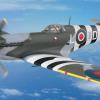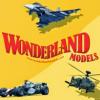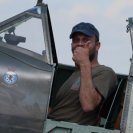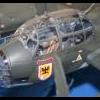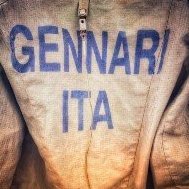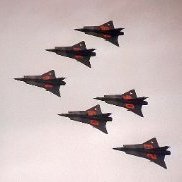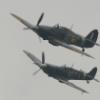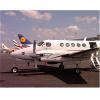Search the Community
Showing results for tags 'revell'.
-
TIE Interceptor 1:90 Revell The TIE Interceptor was introduced as a sister ship to the general purpose TIE Interceptor, I guess to add a little diversity to the chase and battle scenes of Empire. It has cranked "wings" like Vader's TIE Fighter, and a long sloped forward wing section that mounts some large cannons. It looks like it's speeding when standing still, which gives the impression of its function. The type didn't see major use other than as background cannon fodder in the existing films, but maybe it'll see some action in the new one. We shall wait and see. The Kit This is one of the Level 3 range, and as such is more of a traditional kit than any of the Level 1 and 2 snap-together offerings as it requires glue and paint, and it is quite small too, thanks to the scale, which doesn't seem at all consistent throughout the five kits released so far for no apparent reason. That gripe aside, it arrives in a small red themed box with Kylo Ren (the new baddie) menacing us with a light sabre at the top. Inside are three sprues in a TIE Fighter grey/blue styrene, a clear sprue and instruction booklet, which is printed in full colour on matt stock. The first thing that strikes you other than the colour of the styrene and size, is that the detail isn't half bad. It's a fairly simple kit in terms of part-count, but it has been designed in such a way to maximise detail in the process. The instructions are of a new style, having plenty of colour, which looks almost inkjet printed on the thin stock they have used. Some of the symbols are carried over from previous Revell offerings, but the overall impression is much less cluttered. Construction begins with the pilot, which the instructions show to be a seated Kylo Ren, but the styrene provides only a standard TIE Pilot. His chunky chair has large arm-rests with controls embedded, and this sits in the faceted tray that will be familiar to Star Wars kit builders. The side walls are similarly faceted, and the rear wall also has the engine exhausts attached to the rear. The front "instrument panel" finalises the interior. It is placed in the lower hull on three pegs, and the windscreen (vacuumscreen?) has a grey decal applied to the frames, and slots into two grooves in the lower hull. The upper hull and clear roof hatch hold everything in place, and with a little glue, it should all stay put, although the pegs and their receptacles look very much like they originate from a friction-fit kit. The wings have three big ejector pin marks on the inner surface, but other than sanding them flush to allow the detail panel that covers them to fit properly, they shouldn't cause any frustration. Another panel sits on top of the first, and on the outer face a central boss is added, after which the wings can be glued in place, and you're done. Markings Having just the one decal for the windscreen framing, it's mostly about the paint, which Revell as usual give you details of in their own brand. Fortunately, they have Matt Blue-grey in their range, so there's no mixing as often happens when using Revell's limited range of paints. How easy the decal will be to lay down remains to be seen, but there is no carrier film in the clear areas, so it won't be too difficult with the help of some setting solution. Conclusion If these kits had been produced to a consistent scale, they would have appealed to more serious modellers, but they still have some appeal. I would say that they are targeted at the teenager, or the casual modeller, but I'm sure that any modeller would enjoy them. Highly recommended for what it is. Revell model kits are available from all good toy and model retailers. For further information visit
-
Boston Mk. V/A-20J 1:72 Revell The A-20/DB-7 Havoc, better known to those with an interest in the Royal Air Force as the Boston, was a light bomber developed by the Douglas Aircraft Company of Long Beach, California. Designed to a US Air Force specification issued in 1937, the aircraft’s first customer was actually the French Air Force, who had been impressed by its performance whilst visiting the USA as part of a pre-war purchasing commission. Those aircraft not delivered to France by the time the armistice had been signed in 1940 were taken up by the RAF instead. The first squadron to be equipped with the Boston was 88 Squadron of Bomber Command. By the War’s end, no fewer than 24 squadrons had operated the Boston, either as a light bomber or night fighter. A handful of aircraft were converted to Havoc I Turbinlite standard, with a powerful searchlight in the nose, designed to illuminate enemy aircraft for accompanying night fighters. Unfortunately the huge searchlight made the Turbinlites an easy target and this particular chapter of the Boston’s history was not a successful one. The A-20 was also widely used by the USAAF and by the end of the war, almost 7,500 of the type had rolled off the production lines. Revell have been kind to those of us who choose to model in 1:72 scale over the last six weeks or so, as this kit follows hot on the heels of their Harrier GR Mk. 7/9 and Heinkel He 115. As with the aforementioned kits, this is also a re-release of a kit originally tooled by another manufacturer - this time from MPM of the Czech Republic. Nestled inside Revell’s familiar bright blue box are four sprues of grey plastic and a single sprue of clear plastic. Together they hold a total of 118 parts, which is pretty respectable for a kit of this size. There is no flash present anywhere and as far as I can see, there are no flaws in the plastic. Surface details are comprised of fine, engraved panel lines and there is a convincing stretched fabric effect on the rudder and horizontal tail. The overall impression is very favourable indeed. The cockpit is rather well-appointed for this kind of model. It is made up of a floor, seat, rudder pedals, two-part control column, instrument panel, sidewalls and bulkheads. A decal is provided for the instrument panel, but it isn’t really needed as the instruments are picked out with fine, raised details on the plastic parts. The bomb aimer/observer position is just as good and includes a very nice bomb sight. The crew positions are completed by the mid-upper turret, which is a little more basic than the other positions, but still good enough to pass muster. Once the fuselage halves have been joined together, the wings and horizontal stabilisers can be assembled and fixed to the fuselage. The parts have location tabs and slots to help ensure a positive fit. The prominent cowlings, under which hide the large Double-Cyclone engines, each have to be fitted with nine cooling vents. Fortunately Revell’s instructions are very clear in this regard, so you shouldn’t have any problems. The engines themselves are made up of three parts – two rows of seven cylinders and the reduction gearing. They are nicely detailed and should look good once assembled. The undercarriage looks well detailed, but frighteningly complex. Each of the main gear legs is made up of no fewer than six parts, plus the wheels themselves. I would recommend taking great care over these stages in the instructions, lest you end up with a wonky aeroplane when you come to rest it on its tyres. The main gear legs actually fit directly to the wings, and it is possible to fit the rear engine nacelles over these parts afterwards. This should make things a little less frustrating as you will be able to place the parts precisely rather than having to stuff them inside a cramped undercarriage bay. The remainder of the build is concerned with the addition of the transparent parts and the remaining fine details. These include the radio antenna and DF loop as well as the .303 Browning machine guns. The guns are very nicely recreated and the cooling sleeves in particular are convincingly detailed. The transparent parts are thin and clear and shouldn’t present any problems, although I have not been able to check to see how well they fit at this point in time. Two options are provided for on the decal sheet: Douglas Boston Mk. V, No, 13 Squadron, 232 Wing, Royal Air Force, Italy 1944; and Douglas A-20J Havoc, 646th Bomb Squadron, 410th Bomb Group, 9th Air Force, USAAF, Gosfield, England, June 1944. Both aircraft are finished in Olive Drab over Neutral Grey. The decals are nocely printed but they look a little matt. Conclusion As this is the only modern tooling of the Boston in 1:72 scale, it’s fairly easy to recommend it to modellers interested in adding the type to their collection. It looks very good indeed on the sprue, although opinion seems to be divided on how easy it is to build. Some people have reported fit issues whilst others have stated that the kit is a breeze to build. Nevertheless, it is still the best Boston out there and can be firmly recommended. Revell model kits are available from all good toy and model retailers. For further information visit
-
Hello Chaps, I'd like to share with you my completed build of the Revell of Germany newly tooled (last year) 1/32 Focke Wulf Fw190F-8. I usually complete a full build series starting with an in-box-review with updates along the way until completion, but, I've been really busy with a new house my wife and I purchased in December, and so, we're going backwards and forward with contractors. Anyway, I found myself with a spare hour and thought I'd spend it on here! I have to say, this kit is another "Great Value For Money" kit from Revell of Germany; fabulous engineering, quality molded product and a complete joy to build without the need for filler and zero fit issues and looks good built straight out of the box as I did, except for the addition of antenna cables using 1.010" black EZ-Line! Based on the cost alone....I paid $23.95 for it, which is around 16.00 quid when converted, I'd give this kit 5 stars. For everything else, 4.5 stars, just because the instructions are still in black and white, they don't provide alternative paint numbers and the box isn't a sturdy lid and base design. On with the photos, I hope you like her as much as I liked building and painting her! Well, there she is....if you'd like to watch my YouTube Channel "Build Update" and "Final Reveal" videos for this build, then here are the links to those: Build Update #1 video link: https://youtu.be/hwiTyVsZXvI Build Update #2 Video link: https://youtu.be/6hugFcFgpFA Build Update #3 Video link: https://youtu.be/vdPiuCH_0qo Build Update #4 Video link: https://youtu.be/0Bpdc0JwAh4 Final Reveal Video link: https://youtu.be/eSI_qcd9s88 Thanks in advance for taking a look at this posting, watching any of the videos and for your comments, greatly appreciated! Until next time, happy modeling and have fun! Cheers, Martin
- 26 replies
-
- 35
-

-
- Revell
- 1/32 Scale
-
(and 6 more)
Tagged with:
-
We've slashed prices on a fantastic selection of Revell branded model kits from right across the range! Includes Planes, Cars, Trucks, Starter Sets, Ships and more! Stock of these discounted items is very limited so please get your orders in as soon as possible so you don't miss out!! Watch out for more upcoming news about great offers and releases from Wonderland Models! For full details, please see our NEWSLETTER HERE.
-
Hi all,with not a lot going on after the two Thunderbolt,s are finished I fancied a change of era so inspired and jealous by my eldest getting a box full of unbuilt WW1 biplanes from his wifes Grandad(OK he did give me Matchbox's Siskin) I got these two from King Kit at a fiver the Pair,I like to buy older boxing as the molds tend to be better(these two are still current releases).The obvious risk are the decals which due to the kits being fully sealed are in tip top condition so I am building the all red Albatross of Manfred von Richthoven and Goering's all white Fokker.Here's the box and sprue shot's.
-
What was done before 2016 What was done before 2016 - continued First day of 2016 - new decal choice
- 33 replies
-
- 9
-

-
1/72 scale Victor K Mk2 XL163 RAF Marham History, Construction number HP80/66 Awaiting collection 15/05/1961, delivery date 07/02/1962, to Handley-Page Ltd 14/01/1969 then Hawker Siddeley 20/05/1970 for conversion to K2 standard, l/f? 01/07/1986 to St Athan store, to St Athan 29/09/1986 for Battle Damage Repair Training as 8916M, scrapped during 12/1991 by Hanningfield Metals, Stock, Essex "An order was also sent out to the remaining Vulcan Squadron to go on to a War Footing and in a show of force 4 Vulcans were deployed to Wide-awake Airfield at Ascension Island and from there the then longest bombing missions took place. Code named Black Buck, their mission was to deny the Argentinians the use of Port Stanley Airport to their Mirage Fighter jets with 21.000LB's of bombs. One sole Vulcan XM607 Piloted by Sqn Leader Martin withers which was the standby aircraft for the first mission after its sister aircraft XM598 piloted by John Reeve suffered a ruptured windscreen seal in flight and couldn't pressurize. The first raid was successful and placed a bomb right in the centre of the runway. The missions themselves would not have happened if it wasn't for the Victors of 55 and 57 sqn refueling the Vulcan on its route as well as refueling the Victors its self, one specific Victor XL189 piloted by Bob Tuxford gave most of his fuel to XM607 and left with the bare minimum fuel to get back with." The Vulcan was over its normal maximum take-off weighteach carried, as well as extra equipment like the DASH 10 and a chemical toilet, a highly experienced Air to Air Refuelling Instructor (AARI) from the Victor tanker force who would fly the Vulcan during refuellingand fuel usage was higher than expected. As a result of the fuel demand and problems in flight with refuelling, two of the Victors had to fly further south than planned, eating into their own reserves, and one of these, the last Victor to refuel the Vulcan, was past the last refuelling bracket before turning home. Tankers had to be sent south to refuel these Victors so they could reach Ascension. A total of 11 Victors were used to support Black Buck One: XH669, XH672, XL162, XL163, XL188, XL189, XL192, XL232, XL511, XL513 and XM717 XL163, 57 Sqdn, with two wing roundels (copyright prevents posting) ( http://www.57-630sqnassoc.org.uk/forum/viewtopic.php?f=7&t=8353 ) On ascension (copyright prevents posting) ( http://www.abpic.co.uk/photo/1402175/ ) This kit was a "pig" all bent and distorted, raised panel lines etc. etc. I can't scribe but I can sand and boy did this kit need sanding AND filling, the wing needed steaming, it needed heavy duty clamps (carpenters type clamp, that's what I used them for originally! ) to pull the fuselage halves together, everything went up a few notches for tooling to build this thing. I learnt loads while building this, I am used to 1/72 fighters this thing would dwarf most 1/48th kits and even some in 1/32, the wing span is close to a 1/24 spitfire. All techniques I know for assembly went out of the window on this! I used tamiya green/grey and humbrol acrylic white as the tamiya pot looked a bit empty for this job! First go with humbrol acrylic, I must say this, I painted the white before I steamed the wing, the paint held up. The only things I added were a couple of vanes/fins on the fuselage, the centreline one just aft of the cockpit was replaced as it was severely damaged during sanding, otherwise it's out of the box. It's a simple finish but it wasn't without a great deal of effort. Decals, standard format onto gloss with 50:50 Matt/Satin humbrol topcoat, revell decal soft. Box option. This is the first of my V bomber fleet, hopefully I will be able to achieve the remaining aircraft to complete the line up. This type truly has a remarkable history.
- 41 replies
-
- 31
-

-
Hi folk's well January like last year has given us a cracking GB, this time the subject is Republic's Thunderbolt.I picked up two Revell kits and used the kit decal's for a French machine and an Airfix/Academy mix for the RAF machine.I never questioned Academy's colour scheme for the RAF machine and it seems no clear evidence has surfaced only to say that these aircraft were delivered in the scheme and repainted in theatre with the more common brown/green finish,thanks for looking in.I am building the third example soon here's how they build. http://www.britmodeller.com/forums/index.php?/topic/234995068-a-trio-of-revell-p47;s/
- 12 replies
-
- 25
-

-
Hi Guys Here is a Leopard 2A4 NL that is just finished. It's the 1/35 Revell kit with different tracks (Bronco). The netting is made from some bandage soaked in wood glue and painted after drying. Decals are from various decal sheets. Here are the pictures Cheers,
- 12 replies
-
- 15
-

-
Hy folks, this is my first 2016 finished model! I built my Revell's Strike Eagle strictly oob; no after were added, except for the Mk 82 bombs "stolen" from an Academy F-4 Phantom Painted with Guzne H305 (body) and RLM (nose) Great kit, had lot of fun in building! Hope you like it! ciao Ale
- 16 replies
-
- 26
-

-
- strike Eagle
- Revell
-
(and 1 more)
Tagged with:
-
Well I've been dying to do this subject for years and slowly gathered everything together finally obtaining a kit for some £20 off eBay. I'd heard it's absolutely "challenging" which I can confirm it is. I must of used another £20 in filler. The real one was filled with blue circle where as my humble attempt was sponsored by squadron green stuff (it's all about scale you know!). It's taken me some 5 months to do on and off. Anyway my thanks go to John (Canberra kid), BritJet (Steve), DaveT, Alan P and Bill Clark without they're help it would have been even crappier. A colleague at work gave me some resin conversion for free but it was absolutely below par so only used the wiring casting where the 2 CRTs would be. This early representation had virtually no avionics fitted at this stage. The fin camera was added and the fin antennas relocated also adding the "thing" at the trailing edge of the fin tip. I've used the kit undercarriage which has been remarkably sturdy so far. The kit wheels are massively over scale compared to the new release. If you want the quarry lorry look then it can be achieved. Fuel tanks had the winglets replaced with plasticard and the mounting legs added. Ejection seats are from the current revell release. FOD covers are tissue paper, the Skyflash fins are plasticard. Xtracrylix paints were used which for the first time peeled off when masked, but I put that down to the cold conditions of the garage. The bad points - I haven't got the White Skyflash decals on the 4 missiles, I've yet to add the 2 missiles under the shoulder pylons. I think I've made the reprofiled wing fillets with too pointy a leading edge. I've got the fin flash and fin staining to apply yet but at this time I've had enough, hey ho the photos:
- 20 replies
-
- 26
-

-
- Revell
- Tornado F2
-
(and 2 more)
Tagged with:
-
Type 82E German Staff Car 1:35 Revell The Type 82E is best known as the Volkswagen Beetle, the people's car designed by Ferdinand Porsche for the Nazi ideal of a mobile workforce. It was designed for cheapness of manufacturer, to be robust, and to be easily maintained by users, running an air-cooled engine that gave it a distinctive sound that is still recognisable today. Most people probably don't make the link between the hippy-era Beetle and the German Staff car, but there it is. Millions were made over the years, and after production finished in Europe the equipment and toolings were transported to Mexico where they continued to be made for some years. The Kit This is a re-release of a re-release of a re-tooling of a CMK kit from the late 90s, the original of which had a separate roof panel and a few other differences. This latest version has an integral roof panel, with a little nipple in the centre that you'll need to sand off before painting. The kit arrives in one of Revell's new-style boxes with the Level 4 logo giving a guide to the skills needed, and inside is just one sprue of medium grey styrene, plus a bodyshell part placed on the lower body for safety. A clear sprue contains all the windows and lights, while the large instruction booklet is printed in colour in their new style. Hiding in the irritating (but necessary) Health & Safety page are the decals that could easily be thrown away if you regularly chuck these things out, which Revell might do well to take heed of. There are no modern fripperies such as rubberised tyres, but you do get a choice of either the traditional domed hub-cap type, or a 5-stud steel rim, which share a common inner hub that attach to either end of the full-width front axle, or the split rear axles. These are placed under the lower body, and the front axle is trapped in place by an insert. The bumper and over-riders attach to their mounting points, and the clear front and rear light clusters are installed, with either shrouded or unshrouded headlights at your choice. Inside there is a duck-boarded floor, and you add the rear load area, plus the instrument panel and pedal box in between the back of the front fenders. The front seats are padded, and have the pattern moulded in, with some ejector-pin marks on the rear, and C-shaped runners holding them off the floor. The rear seats are a single bench, and fit just forward of the rear arches, with a transmission tunnel containing the gear lever and hand brake (remember those?) running fore to aft. Turning to the bodyshell, the roof nipple will need removing first, after which you can add the door cards and rear-view mirror. The head lining is just the inside of the roof, although I'm not 100% sure whether that's accurate, it will need a little clean-up at the front to make it presentable. With the interior complete and painted, the windows are then added, which are all individual panels that are fitted from the outside, so take care to test-fit and fettle where necessary before resorting to glue. The bodyshell is then glued to the lower, and fits very well, so shouldn't need any filler at all. You'll probably leave the door handles, bonnet/hood handle and windscreen wipers off until after main painting. Markings Surprisingly there are three markings options in the box, differing in terms of number plates and colour schemes, with a number of common stencils in white or black. From the box you can build one of the following: German Army 1943-5 WH-49760 – sand/green wavy camo & domed hubcaps. German Army 1943-5 WH-1123 458 – Panzer grey & steel rims. German Army 1943-5 WH-1400 382 – Sand & steel rims. Decals aren't Cartograf, but are still printed in Italy, with good register, colour density and sharpness. The sheet includes an instrument dial for the driver's panel, which is a nice touch. Conclusion An ageing but still useful little kit that would benefit from some nicer wheels to spruce it up. Adding a little weighting by sanding the bottoms of the tyres flat will definitely help however. Recommended. Revell model kits are available from all good toy and model retailers. For further information visit
-
- Hi, I'm Sebastien and I'm a Tornadoholic - Hi Sebastien. This kit is lovely, and now I have two under my belt and a dozen or so to build, I thought I might do a WIP. My point isn't to build the ultimate Tornado. I couldn't, and the one and only General Melchett is doing a brilliant job about it. I'm just here to help average modellers like me to avoid the little troubles you can have building this kit. So I'll accept all pointers, kicks in the butt, subtle and not so subtle hints and bribes Lagavulin pieces of advice you'll throw my way, and be grateful about them. Now, on with the build. I started by more or less following the instructions (yeah, I know, who does that?), and assembled the cockpit to the fuselage bottow and front wheel well : I glued the WSO instrument panel and while the glue was setting, I dry fitted a nose wall to the fuselage. That way, the instrument panel took its intended position without fuss. I scrounged the IPs from a Tornado IDS and the console panels from the GR4 kit: Then it was time to install the air intakes, without gluing the front to the fuselage: Now, the intake ramps. On the left, how they should be for a Tornado sitting on the ground. On the right, how they are in the box. You have to remove the protruding bit. Shaun, thanks for the tip. The intake fronts are assembled and glued to the nose walls. The nose walls are dryfitted to the fuselage: The importance of not gluing the intake block front to the fuselage is there: now, you have some leeway to adjust everything. I don't remember who wrote about that here, and I'm sorry, but whoever you are, thanks a lot. To be continued.
- 22 replies
-
- 9
-

-
MQ-9 Reaper French Airforce 1/33 "Belfort" operation Barkhane 1/48 Kinetic kit reboxed by Revell decals: he excellent ones from Caracal Models WiP: http://www.britmodeller.com/forums/index.php?/topic/234992379-mq-9-reaper-french-airforce-133-belfort-operation-barkhane-148/ finally finished! was definitely more than a weekend project as initially planned! first, I identified the need to know a bit more about the Reaper, then I noticed that France operates a more modern version than the kit represented, then I needed to modify,....etc. you know this, don't you? but here you are all the necessary mods: , no photoshop, he! just natural sunlight reflection! thanks for comments! Salut, Werner
-
Hello! As a late christmas gift, let me introduce my finished F-4ETM. Actually its done for a while, but I had no time to shot some almost good pics and write this text, thanks for my exterminations examinations. Whatever... Some of them made with and without flashlight, I can not decide which tone is closer to the real.
- 12 replies
-
- 18
-

-
- Türk Hava Kuvvetleri
- Turkis Air Force
-
(and 4 more)
Tagged with:
-
Good morning, 25 years ago, Desert Storm started. One of the many players in it was the "Bradley" APC (or IFV?). Well, since I usually don't do military modelling, I guess you know much more about than I do anyway! The kit is from Revell, and built OOB, except the antennaes. Fitting was good, just had some problems with the tracks. But I guess it was due to my poor experience. Painting was done with Modelmaster Marines Desert Sand, weathering was some filtering and washing with oil colours. All in all, a nice kit, which can be recommanded. As this is one of my few military things, I appreciate any feedback, and ways to improve the technique. I should add some soot at the exhaust, maybe some luggage as well. We'll see! Alex
- 2 replies
-
- 15
-

-
- Desert Storm
- Revell
-
(and 2 more)
Tagged with:
-
Well here she is folks, a fun, if challenging, build! Representing a machine flown by Jean Navarre of Escadrille MS12, Muizon, France, October 1915 To sum it up: Fuselage shortened by 11.5mm, turtledeck lowered by 2mm, rear fuselage widened by 5mm, entire fuselage reskinned, 2.5mm removed from wing trailing edges, 2mm added to wing roots, wings raised by 1mm. All struts, tail surfaces, and landing gear scratch built. Aeroclub wheels and MG, prop and spinner modified from spares box items. Close, Revell, so close! ] Thanks for following along! Ian
- 14 replies
-
- 19
-

-
- Limeypilot
- Revell
-
(and 1 more)
Tagged with:
-
Hi All, i'm building the Revell Victor, and haven't got the cash to splash on the detail kit to deal with the intakes. As I was going to build it on the ground i'll go for FOD covers. in the past I've done this with cut out paper, but it always looks naff. Any ideas/advice/tips on how to make really realistic and stable red FOD covers for the intakes? A la: http://thumbsnap.com/s/nwp4X5Nc.png Chris
-
New hopefully fast "weekend" project: MQ-9 Reaper French Airforce 1/33 "Belfort" operation Barkhane 1/48 Kinetic kit reboxed by Revell decals will be the excellent ones from Caracal Models decals: main parts: good fit, no glue yet!: no actually small... as far as I know France does not arm its Reapers as of yet, so a clean recce drone it will be
- 15 replies
-
- 3
-

-
Dornier Do 215 B-5 1:48 Revell The Do 215B-5 Kauz III followed the lead of the Do 17Z-10 "Kauz II", with a streamlined solid nose that housed 4 x 7.9mm MG17 machine guns and a single 20mm MG FF cannon (some sources state two cannons). An infra-red sensor was also fitted, part of the Spanner-Anlage system that was intended to pick up the hot exhausts of enemy bombers, with a small Q-Rohr display screen installed in the cockpit. In practice, the device proved to be of very limited value, as it was very unreliable and could not differentiate between friend and foe. The Do 215B-5 entered service with 4./NJG 1 in early 1941, with around 20 aircraft eventually being modified to carried the FuG 202 Lichtenstein B/C radar system. While the clumsy aerial array knocked around 15 mph off the aircraft's top speed, the first "kill" was claimed in August 1941, with additional victories soon following. The Do 215B-5 soldiered on in limited numbers until 1944, with its original armament augmented by an additional pair of cannon mounted side-by-side in a pack under the nose. The Kit The kit is a Revell boxing using the plastic of ICM. The box is somewhat large for the contents. On opening, all the standard sprues are contained in a single poly bag with only the clear parts separately packed in their own bag. The five sprues of medium grey styrene are very nicely moulded, with no sign of flash and only a few moulding pips. Whilst the details such as the panel lines are very finely done there are quite a few flow marks in the plastic, although these should disappear under a coat of primer. The clear parts though are blemish free and remarkably clear which is a good job as there is quite a bit of detail within the cockpit area, in fact the whole kit is well stocked with detail. Construction begins with the fitting of the lower side console in the port fuselage part, followed by the throttle box, a panel full of levers and the radio panel. The two part instrument panel is then fitted, decals being provided for the instruments, along with a large trim wheel attached to a tripod structure. The pilots seating section is made up of the floor, two rudder pedals, each made up of two parts, the control column with separate yoke and the floor support frame. The assembly is completed with the fitting of the seat and compass housing, before the whole assembly is fitted to the fuselage side. The lower rear longeron structure is then fitted, as is the rear side window. In the starboard fuselage more switch panels, a map case, and auxiliary instrument panels are attached, along with the front and rear lower longeron structures. The three piece co-pilots seat is then assembled and glued into position. There are three bulkheads to be fitted to one of the fuselage sides and the tail wheel before the fuselage can be closed up. The rear gunners seat is then assembled and attached to the two support frames in the fuselage. A fourth bulkhead is slid into position just aft of the rear cockpit bulkhead, whilst the panels underside of the cockpit are also attached, the clear section having an optional cut out panel replaced with one that doesnt have a machine gun opening, probably a legacy part from the previous bomber version. The large fuselage mounted fuel tank is then assembled and slid between the front two bulkheads. Moving onto the wings; the two lower sections are fitted with two part radiators and fairings, before being glued to the single piece upper wing, followed by the separate ailerons and landing lamp cover. The wing assembly is then attached to the fuselage and the aircraft begins to really take shape. The kit comes with complete with two complete engines, which whilst not the most detailed, certainly give the modeller a good starting point for some super detailing. Each engine is made up of a five piece block, separate rocker covers, inlet manifold and a three piece turbocharger. The engines are then fitted with the two engine bearers and put to one side whilst the nacelles are constructed. Each nacelle comes in two halves and are fitted out with the engine mounting bulkhead, radiator, radiator inlet and outlet doors, main gear bay rear bulkhead, exhaust stubs, gear retraction jacks and linkages plus the upper and lower cowlings, which can be left loose once the engines have ben attached to their respective bulkheads. Each main landing gear is made up of two part wheels/tyres, the two oleos, complete with cross braces are provided as a single part and fitted with the mudguard and its associated mounting beam. The completed units are then slid in to the front of the gear bays and connected to the retraction actuators. The completed nacelles are then attached to the wings and fitted with the two part propellers. Meanwhile the bomb racks are fitted into the still open bomb-bay and the rear machine gun for the cockpit is assembled from the gun, ammunition drums and spent cartridge bag. The machine gun is then fitted to the rear of the canopy, whilst on top, the aerial, DF dome and armoured wind shield, which has an option of being enclosed, or with an opening for an external telescopic? gunsight are attached. The canopy can then be fitted to the airframe along with the underside rear cupola glazing. The solid nose cone is fitted out with the machine gun and cannon barrels, as well as the extreme nose panel. On the underside the bomb-bay doors can be posed open or closed and just aft of the bomb-bay the HF aerial rail is attached. The horizontal and vertical tailplanes are each made up of two halves to which the single piece rudders and elevators are attached along with the elevator control arms. The vertical tailplanes/rudders are then attached to the horizontal tailplanes and each assembly attached to the rear fuselage. To complete the build the aerials for the Fug 202 radar are carefully assembled from four aerial masts to which four dipoles are attached to each and fitted to the nose cone. Although injection moulded the aerials are quite slender, but for those who wish to have some that are more to scale Owl models do an etched set that can be used instead. Decals The decal sheet in this kit like many other new ones is made in Portugal. The decals are quite matt. The printing is off a little with the smaller stencils not being able to be read, which they should be in this scale. Some of the other smaller decals are very indistinct. The sheet offers two options; Stab II. NJG2, Leeuwarden 1942 (Green/Grey camo as per box art) NJG2, Giltze-Rijen 1941 (Overall black) As this is a Revell Kit no swastikas are provided. Conclusion It would seem with this re-boxing that the sprues have been slightly tweaked and the correct style shrouded exhaust covers and ventral gondola are now in the kit which makes a big difference. Recommended. Revell model kits are available from all good toy and model retailers. For further information visit
-
The Story of Revell - Vol I 1950 to 1986 Histoire & Collections - Casemate Publishing Revell is without doubt one of the major players in model kits world wide, and has been so for a while. How many of us know just how long though? It would seem the origins of the company go back as far as 1941 when an electrical engineer, Lewis Glaser, founded a toys distribution firm: the "Precision Specialities". This company would later become the Revell we know in the 1950s. This book medium format paperback, 80 pages long by author Jean-Christophe Carbonel spans Revell USA until 1986. The book has photos of various model kits produced over the years, and historical events. It is interesting to see the development of box art over the years. Included is the use of Penthouse pets to introduce the 1974 Revell line up in the UK, imagine the outcry if they tried that today! It also seems re-boxing other manufactures kits is not new, and this is covered in the book as well. Conclusion Whether it is to do some research, or more likely for a trip down memory lane; modellers will like this book. Recommended. Review sample courtesy of
-
well here comes my next attempt..... one1/72 revell Mk Vb & one new tool 1/48 Mk Vb Both will be built wheels up, with clipped wings & the same camouflage colours. I'll be relying heavily on Styx' build from last year to try & get this one right. so here's my first question - it regards the clipped wings on A-EA. I took some pics of her a couple of years ago at Duxford & the wings appear to be full length, then I took some more of her at Goodwood this year & they're clipped. Has the aircraft been modified, or are the tips removable ?!!! here are a couple of pics: firstly with full wings notice how the '0' of EP120 is hidden behind the 'A' ? and then this year with clipped wings: I reckon these two should keep me going till xmas.
-
Hi folk's second German utility vehicle finished,Revell,s quite new kit built along with Italeri's Kubelwagen,great fun build with no vices and some beautiful molding's.Background to the build's here. http://www.britmodeller.com/forums/index.php?/topic/234993049-wehrmacht-runnerounds-beetle-kubelwagen/ Thank's for looking in.
-
What about a bit of colour to kick off 2016 in the manner I want to continue! Built over the Christmas break, this is Revell's rather simple Do228 kit, updated to reflect one of the Dutch Coastguard's current coastal patrol variant with added lumps, bumps and other antennae/sensors. The kit itself is a straightforward build with remarkably good fit, although Revell seem to have missed out some key features of the aircraft, like the prominent landing lights and inexplicably want you to stretch sprue for some important (and IMHO, entirely mouldable) key details like the Fowler Flap actuators. Out the box, the kit represents two very early aircraft without the current radar/optical sensor suite, but at least on the surface, the changes to the current aircraft are not too difficult to scratch. The Dutch colour scheme is a little more complex than average and did severely task my masking skills (there is a marginally simpler German Navy scheme provided too); to be fair though, I did diverge from the straightforward older scheme provided in the decals and was determined to add the complex black "Toucan" nose. I have added quite a few scratch details; the SLAR antennae, FLIR turret, modified cargo door, various aerials etc all from the spares box or bits of sprue. I also added some engine exhausts from plastic tube - a strange omission by Revell! FredT
-
Messerschmitt Bf-109G-10. My second interpretation of famous "White 11 - Rosemarie", this time in 1/72. This time I`ve changed some colors on fuselage and added ETC-50/VIIId bomb rack underside (it is believed that "Rosemarie" carried one in May 1945). Revell kit + some Eduard`s PE parts + resin propeller, spinner and exhausts from Quickboost + vacu canopy from Rob Taurus + ETC-50/VIIId from ICM Bf-109E-7 kit + some scratch build. Decals mixed from DP Casper, Kagero and Revell. Thanks for watching!
- 10 replies
-
- 25
-




